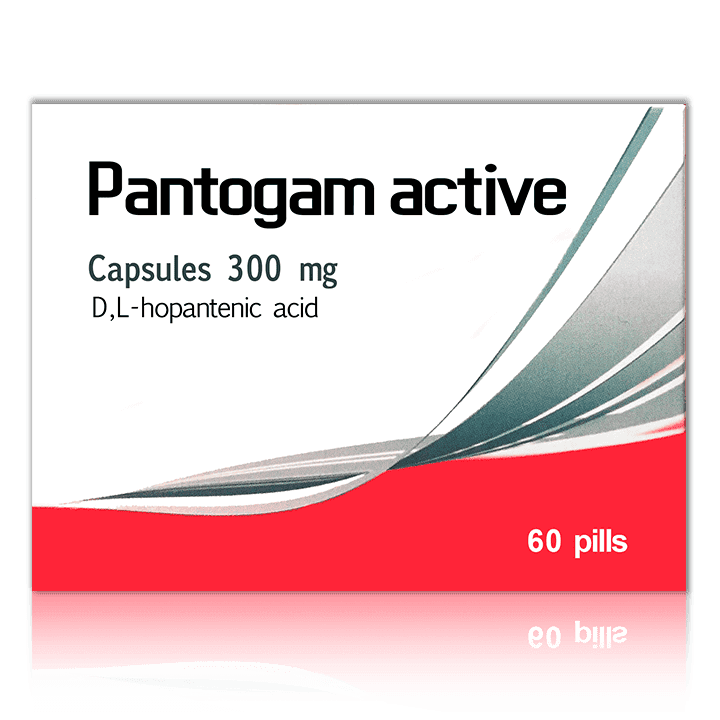Pantogam® (D-, L-hopantenic acid) Instruction
International Non-Proprietary Name (INN): D-, L-hopantenic acid
Dosage form: capsules
Structure
1 capsule contains:
Active ingredient: rac-hopantenic acid (D-, L-hopantenic acid) 300 g.
Excipients: microcrystalline cellulose, magnesium stearate; hard gelatin capsules №0;
Capsule composition: gelatin, titanium dioxide.
Description
Firm gelatine capsules of white color, size №0; the capsule’s content is powder of white or white with a yellowish tint color
Pharmacological classification: nootropic
ATC code: N06BX
Pharmacological action: anticonvulsant, nootropic

Pharmacodynamics
The action of Pantogam Active® is connected with the presence of gamma-aminobutyric acid in its structure, which directly affects the GABABR-receptor-channel complex. Pantogam Active® is a racemic mixture of equal amounts of R-form of hopantenic acid and its S-isomer. The presence of the isomer improves the transportation and interaction of the medicine with the GABA receptor. Pantogam Active® has a more pronounced nootropic and anticonvulsant action than medicines of the first-generation hopantenic acid.
Pantogam Active® increases the resistance of the brain to hypoxia and the effects of toxic substances; it stimulates anabolic processes in neurons, combines moderate sedative action with a mild stimulating effect. Has an anti-asthenic and light anti-anxiety effect. Reduces motor excitability, regulates behavior. Activates mental activity and performance. Causes inhibition of the pathologically increased visceral reflex and detrusor tonus.
Pharmacokinetics
It is quickly absorbed from the gastrointestinal tract. Penetrates through the blood-brain barrier. Is not metabolized and is excreted in the unchanged form during 48 hours: about 70% of the dose is excreted in the urine, about 30% – in feces.
Intended uses
- cognitive impairment in case of organic brain damage (including the consequences of neuroinfections and craniocerebral injuries) and neurotic disorders;
- cerebrovascular insufficiency, caused by atherosclerotic changes in cerebral vessels;
- extrapyramidal hyperkinesis (myoclonus-epilepsy, Huntington’s chorea, hepatolenticular degeneration, Parkinson’s disease, etc.), and extrapyramidal syndrome caused by the administration of neuroleptics;
- the medicine is taken in combination with anticonvulsants for epilepsy treatment;
- psycho-emotional overloads, reduced mental and physical performance, for improvement of concentration and memory;
- neurogenic disorders of urination (pollakiuria, urgency, urge incontinence, enuresis);
- as part of the complex therapy for treating schizophrenia.
Contraindications
- hypersensitivity;
- acute severe kidney disease;
- pregnancy and lactation;
- patients under 18 years old (no clinical studies have been made on the use of the medicine at the age under 18).
Dosage and administration
Per os. In 15–20 minutes after meals, 1–3 capsules (0.3–0.9 g) 2-3 times a day, preferably in the morning and afternoon. The maximum daily dose is 8 capsules (2.4 g). The course of treatment is 1–4 months, sometimes up to 6–12 months. After 3–6 months, the course of treatment can be repeated.
Side effects
Immune system disorders
Rare: Allergic reactions such as rhinitis, conjunctivitis, skin rashes.
Psychic disorders
Rare: Sleep disturbances or drowsiness.
Central nervous system (CNS) disorders
Headache, dizziness, noise in the head.
Digestive system disorders
Nausea, epigastric pain.
In case of immune system disorders, the medicine is cancelled. In other cases, the dosage is reduced.
Overdose
Symptoms
Increased severity of side effects.
Treatment
Activated charcoal, gastric lavage, symptomatic therapy.
Interaction with other drugs
Prolongs the effect of barbiturates, enhances the effects of anticonvulsants and prevents side effects of phenobarbital, carbamazepine, and neuroleptics.
The Pantogam Active® effect is enhanced when combined with glycine, etidronic acid.
The medicine potentiates the action of local anesthetics (procaine).
In case of the long-term treatment, simultaneous administration of the medicine with other nootropic and CNS-stimulating medicines is not recommended.
Pregnancy and lactation
The medication is contraindicated during pregnancy (1st trimester) and lactation.
Influence on the ability to drive vehicles and operate mechanisms
No data available.
Storage conditions
Store in a dry, dark place at a temperature no higher than 25°C. Keep out of reach of children.
Shelf life
3 years. Do not use beyond the expiration date.
Manufacturer
PIQ-Pharma, Russia. https://www.piqpharma.com/